Analysis of Project Change Management: Time, Cost, and Quality Aspects
VerifiedAdded on 2020/05/11
|8
|1446
|56
Report
AI Summary
This report provides a comprehensive analysis of project change management, addressing critical aspects such as time, cost, and quality impacts. It examines the inevitability of change in projects and the importance of change control processes. The report explores how changes affect project duration, budget, and deliverables, highlighting techniques to manage these impacts, including scope reduction and budget adjustments. It also discusses options for handling change requests, including filling out forms, reviewing requests, defining options, and making final decisions, while also addressing the associated risks. Furthermore, the report explains scope creep, its causes, and provides examples like the Denver International Airport Baggage handling system, and effective management techniques such as clear scope definition and change control processes. The report references various project management resources to support its findings.
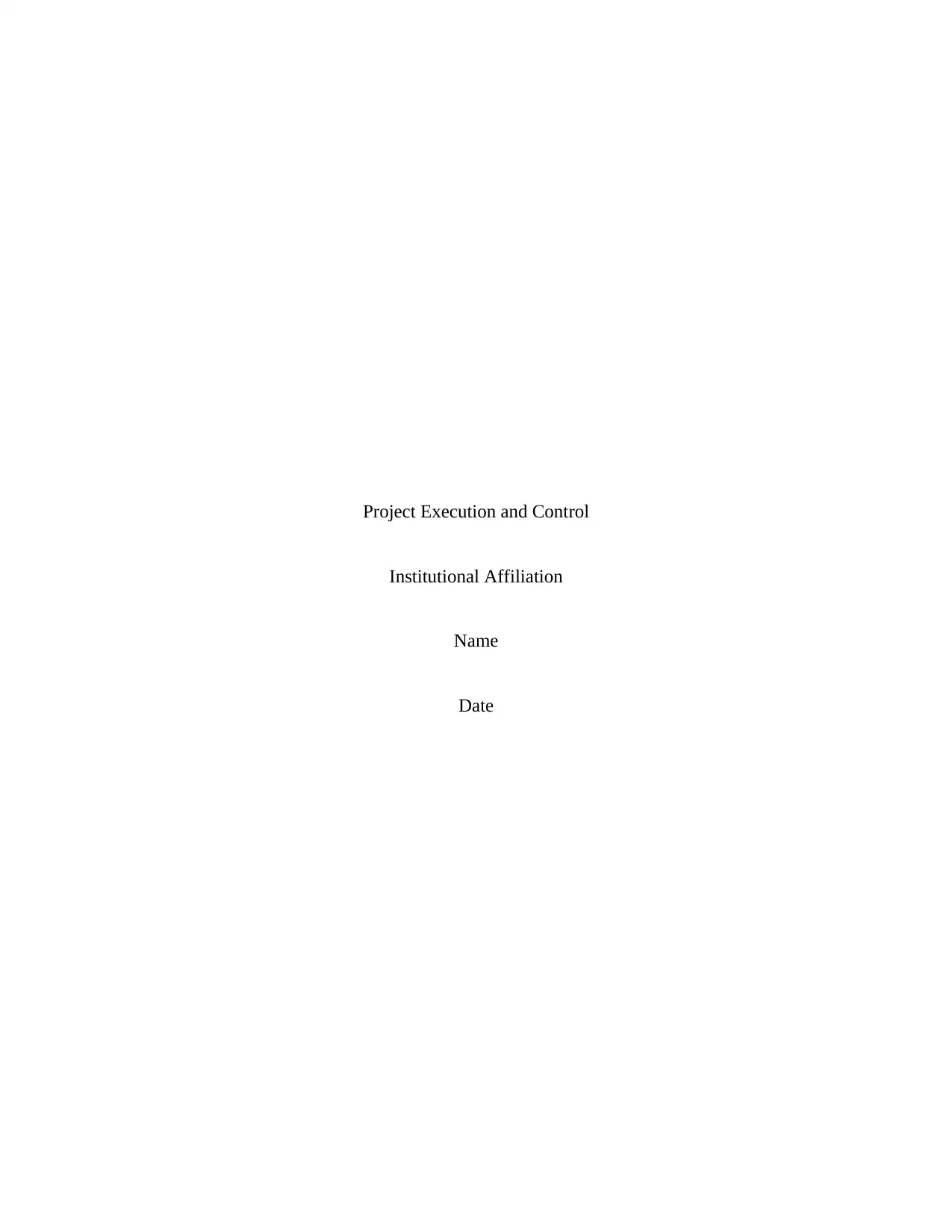
Project Execution and Control
Institutional Affiliation
Name
Date
Institutional Affiliation
Name
Date
Paraphrase This Document
Need a fresh take? Get an instant paraphrase of this document with our AI Paraphraser
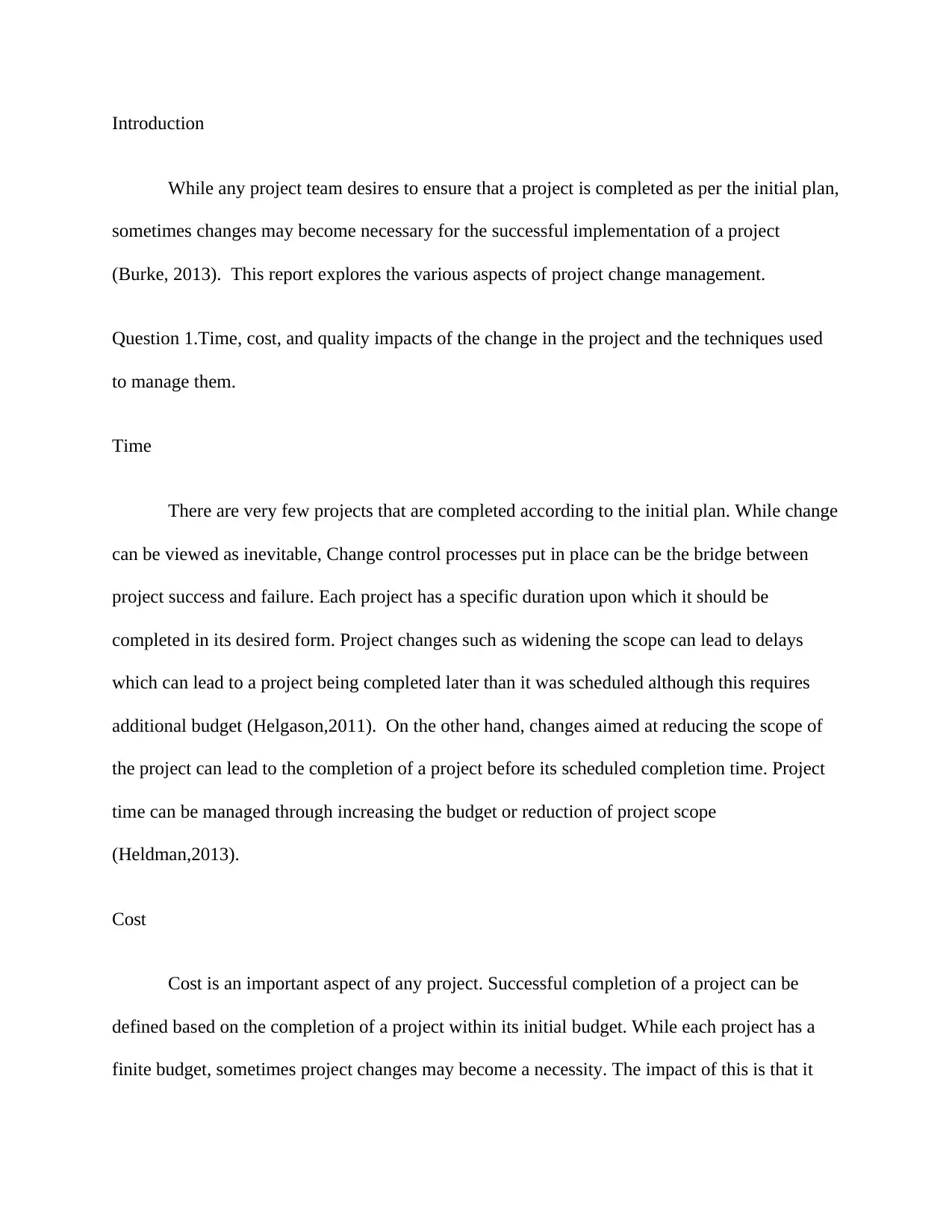
Introduction
While any project team desires to ensure that a project is completed as per the initial plan,
sometimes changes may become necessary for the successful implementation of a project
(Burke, 2013). This report explores the various aspects of project change management.
Question 1.Time, cost, and quality impacts of the change in the project and the techniques used
to manage them.
Time
There are very few projects that are completed according to the initial plan. While change
can be viewed as inevitable, Change control processes put in place can be the bridge between
project success and failure. Each project has a specific duration upon which it should be
completed in its desired form. Project changes such as widening the scope can lead to delays
which can lead to a project being completed later than it was scheduled although this requires
additional budget (Helgason,2011). On the other hand, changes aimed at reducing the scope of
the project can lead to the completion of a project before its scheduled completion time. Project
time can be managed through increasing the budget or reduction of project scope
(Heldman,2013).
Cost
Cost is an important aspect of any project. Successful completion of a project can be
defined based on the completion of a project within its initial budget. While each project has a
finite budget, sometimes project changes may become a necessity. The impact of this is that it
While any project team desires to ensure that a project is completed as per the initial plan,
sometimes changes may become necessary for the successful implementation of a project
(Burke, 2013). This report explores the various aspects of project change management.
Question 1.Time, cost, and quality impacts of the change in the project and the techniques used
to manage them.
Time
There are very few projects that are completed according to the initial plan. While change
can be viewed as inevitable, Change control processes put in place can be the bridge between
project success and failure. Each project has a specific duration upon which it should be
completed in its desired form. Project changes such as widening the scope can lead to delays
which can lead to a project being completed later than it was scheduled although this requires
additional budget (Helgason,2011). On the other hand, changes aimed at reducing the scope of
the project can lead to the completion of a project before its scheduled completion time. Project
time can be managed through increasing the budget or reduction of project scope
(Heldman,2013).
Cost
Cost is an important aspect of any project. Successful completion of a project can be
defined based on the completion of a project within its initial budget. While each project has a
finite budget, sometimes project changes may become a necessity. The impact of this is that it
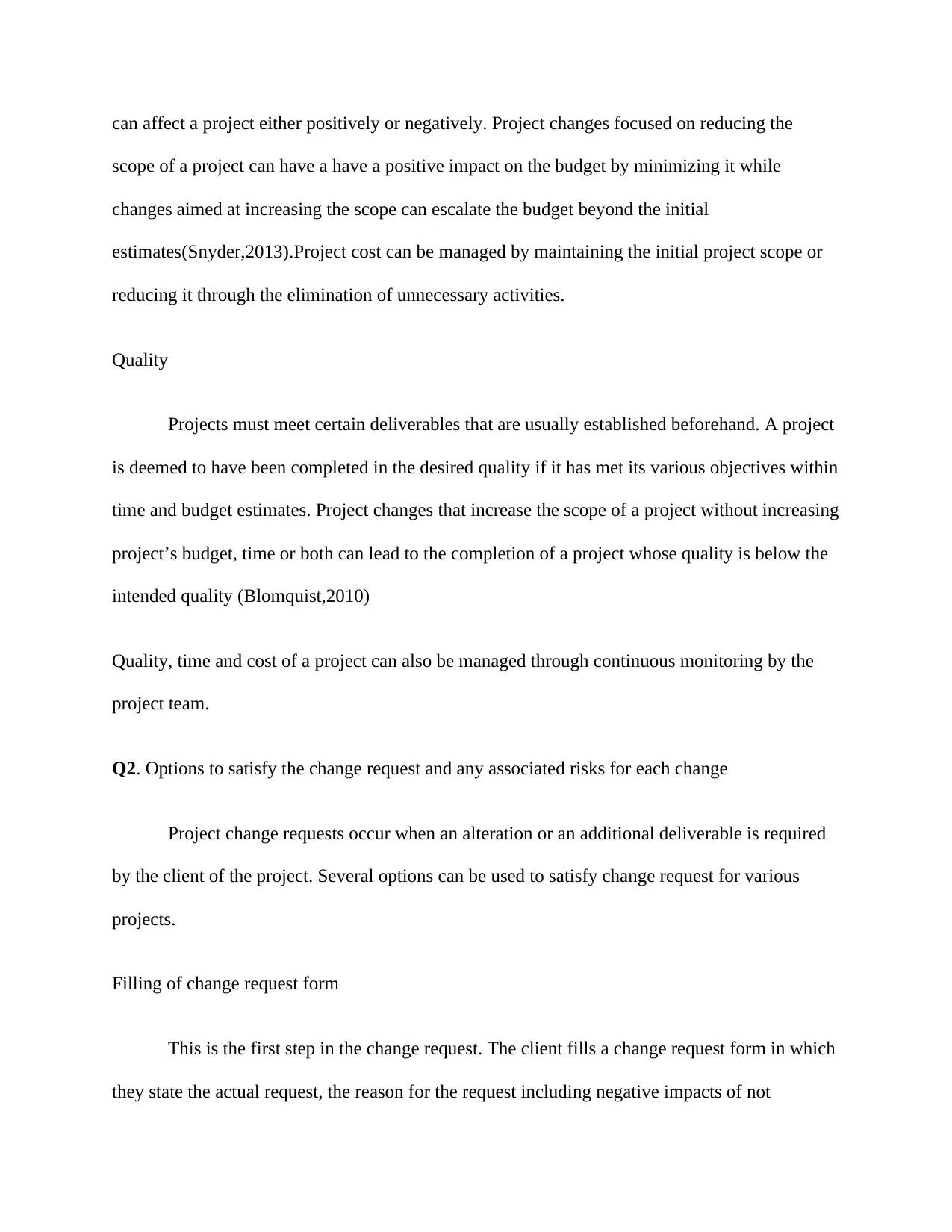
can affect a project either positively or negatively. Project changes focused on reducing the
scope of a project can have a have a positive impact on the budget by minimizing it while
changes aimed at increasing the scope can escalate the budget beyond the initial
estimates(Snyder,2013).Project cost can be managed by maintaining the initial project scope or
reducing it through the elimination of unnecessary activities.
Quality
Projects must meet certain deliverables that are usually established beforehand. A project
is deemed to have been completed in the desired quality if it has met its various objectives within
time and budget estimates. Project changes that increase the scope of a project without increasing
project’s budget, time or both can lead to the completion of a project whose quality is below the
intended quality (Blomquist,2010)
Quality, time and cost of a project can also be managed through continuous monitoring by the
project team.
Q2. Options to satisfy the change request and any associated risks for each change
Project change requests occur when an alteration or an additional deliverable is required
by the client of the project. Several options can be used to satisfy change request for various
projects.
Filling of change request form
This is the first step in the change request. The client fills a change request form in which
they state the actual request, the reason for the request including negative impacts of not
scope of a project can have a have a positive impact on the budget by minimizing it while
changes aimed at increasing the scope can escalate the budget beyond the initial
estimates(Snyder,2013).Project cost can be managed by maintaining the initial project scope or
reducing it through the elimination of unnecessary activities.
Quality
Projects must meet certain deliverables that are usually established beforehand. A project
is deemed to have been completed in the desired quality if it has met its various objectives within
time and budget estimates. Project changes that increase the scope of a project without increasing
project’s budget, time or both can lead to the completion of a project whose quality is below the
intended quality (Blomquist,2010)
Quality, time and cost of a project can also be managed through continuous monitoring by the
project team.
Q2. Options to satisfy the change request and any associated risks for each change
Project change requests occur when an alteration or an additional deliverable is required
by the client of the project. Several options can be used to satisfy change request for various
projects.
Filling of change request form
This is the first step in the change request. The client fills a change request form in which
they state the actual request, the reason for the request including negative impacts of not
⊘ This is a preview!⊘
Do you want full access?
Subscribe today to unlock all pages.

Trusted by 1+ million students worldwide
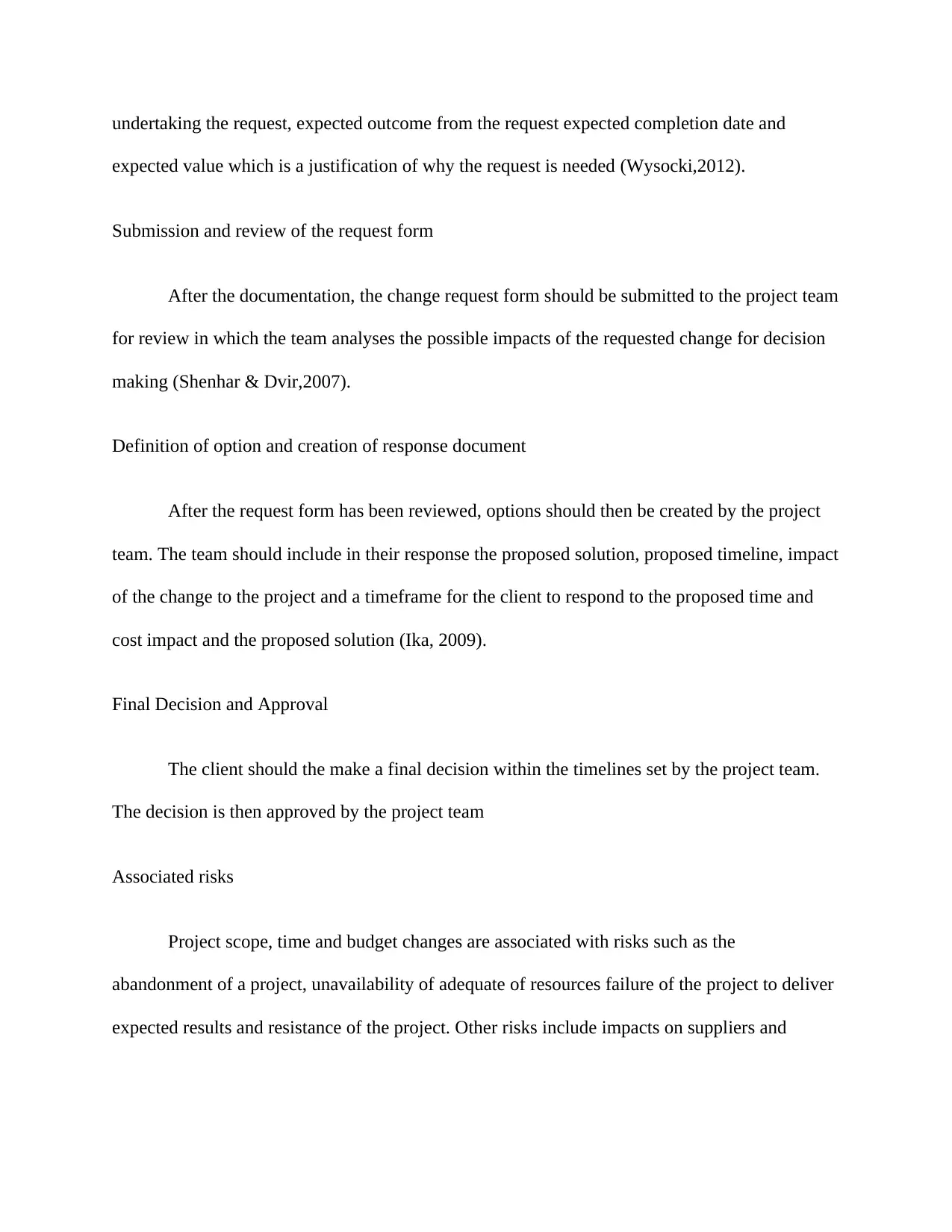
undertaking the request, expected outcome from the request expected completion date and
expected value which is a justification of why the request is needed (Wysocki,2012).
Submission and review of the request form
After the documentation, the change request form should be submitted to the project team
for review in which the team analyses the possible impacts of the requested change for decision
making (Shenhar & Dvir,2007).
Definition of option and creation of response document
After the request form has been reviewed, options should then be created by the project
team. The team should include in their response the proposed solution, proposed timeline, impact
of the change to the project and a timeframe for the client to respond to the proposed time and
cost impact and the proposed solution (Ika, 2009).
Final Decision and Approval
The client should the make a final decision within the timelines set by the project team.
The decision is then approved by the project team
Associated risks
Project scope, time and budget changes are associated with risks such as the
abandonment of a project, unavailability of adequate of resources failure of the project to deliver
expected results and resistance of the project. Other risks include impacts on suppliers and
expected value which is a justification of why the request is needed (Wysocki,2012).
Submission and review of the request form
After the documentation, the change request form should be submitted to the project team
for review in which the team analyses the possible impacts of the requested change for decision
making (Shenhar & Dvir,2007).
Definition of option and creation of response document
After the request form has been reviewed, options should then be created by the project
team. The team should include in their response the proposed solution, proposed timeline, impact
of the change to the project and a timeframe for the client to respond to the proposed time and
cost impact and the proposed solution (Ika, 2009).
Final Decision and Approval
The client should the make a final decision within the timelines set by the project team.
The decision is then approved by the project team
Associated risks
Project scope, time and budget changes are associated with risks such as the
abandonment of a project, unavailability of adequate of resources failure of the project to deliver
expected results and resistance of the project. Other risks include impacts on suppliers and
Paraphrase This Document
Need a fresh take? Get an instant paraphrase of this document with our AI Paraphraser
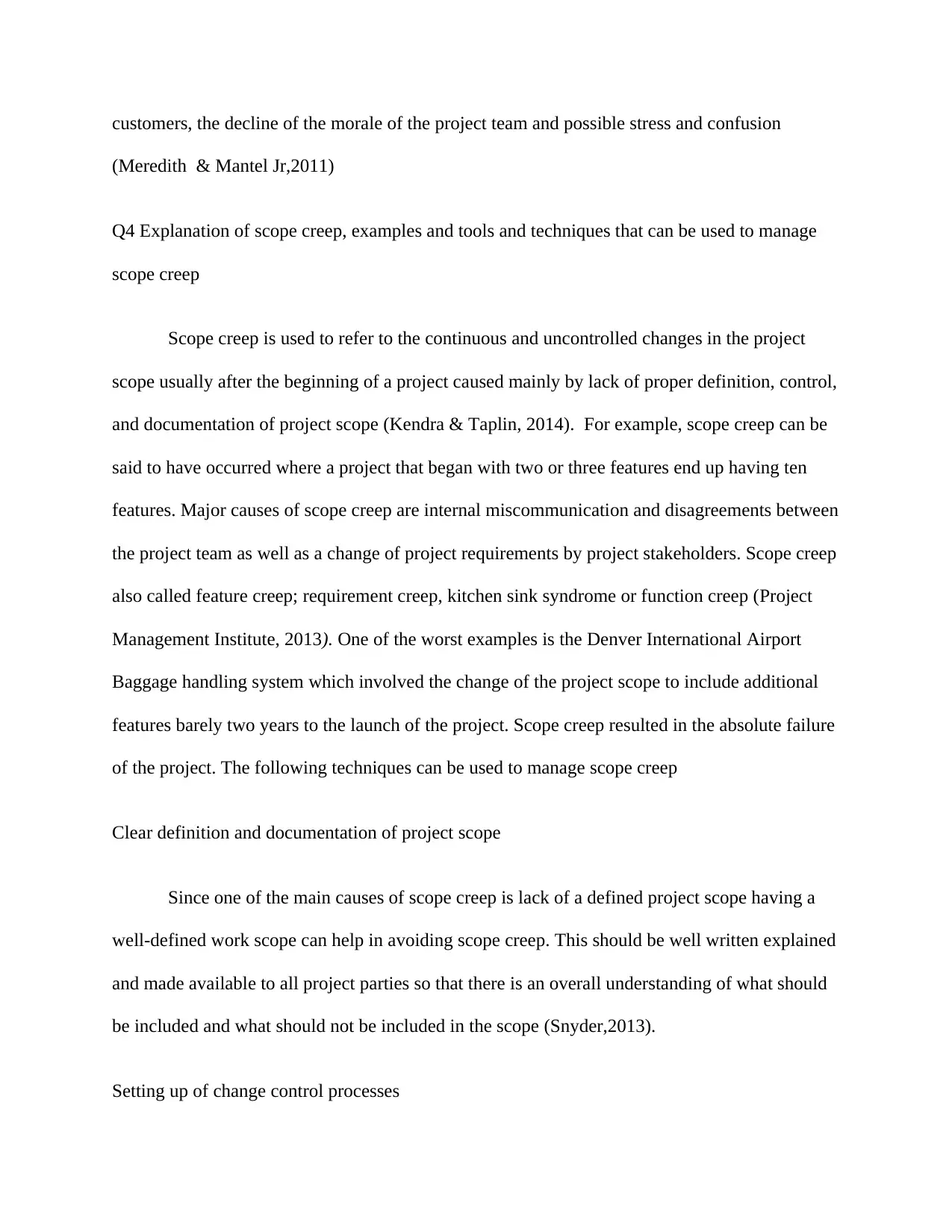
customers, the decline of the morale of the project team and possible stress and confusion
(Meredith & Mantel Jr,2011)
Q4 Explanation of scope creep, examples and tools and techniques that can be used to manage
scope creep
Scope creep is used to refer to the continuous and uncontrolled changes in the project
scope usually after the beginning of a project caused mainly by lack of proper definition, control,
and documentation of project scope (Kendra & Taplin, 2014). For example, scope creep can be
said to have occurred where a project that began with two or three features end up having ten
features. Major causes of scope creep are internal miscommunication and disagreements between
the project team as well as a change of project requirements by project stakeholders. Scope creep
also called feature creep; requirement creep, kitchen sink syndrome or function creep (Project
Management Institute, 2013). One of the worst examples is the Denver International Airport
Baggage handling system which involved the change of the project scope to include additional
features barely two years to the launch of the project. Scope creep resulted in the absolute failure
of the project. The following techniques can be used to manage scope creep
Clear definition and documentation of project scope
Since one of the main causes of scope creep is lack of a defined project scope having a
well-defined work scope can help in avoiding scope creep. This should be well written explained
and made available to all project parties so that there is an overall understanding of what should
be included and what should not be included in the scope (Snyder,2013).
Setting up of change control processes
(Meredith & Mantel Jr,2011)
Q4 Explanation of scope creep, examples and tools and techniques that can be used to manage
scope creep
Scope creep is used to refer to the continuous and uncontrolled changes in the project
scope usually after the beginning of a project caused mainly by lack of proper definition, control,
and documentation of project scope (Kendra & Taplin, 2014). For example, scope creep can be
said to have occurred where a project that began with two or three features end up having ten
features. Major causes of scope creep are internal miscommunication and disagreements between
the project team as well as a change of project requirements by project stakeholders. Scope creep
also called feature creep; requirement creep, kitchen sink syndrome or function creep (Project
Management Institute, 2013). One of the worst examples is the Denver International Airport
Baggage handling system which involved the change of the project scope to include additional
features barely two years to the launch of the project. Scope creep resulted in the absolute failure
of the project. The following techniques can be used to manage scope creep
Clear definition and documentation of project scope
Since one of the main causes of scope creep is lack of a defined project scope having a
well-defined work scope can help in avoiding scope creep. This should be well written explained
and made available to all project parties so that there is an overall understanding of what should
be included and what should not be included in the scope (Snyder,2013).
Setting up of change control processes
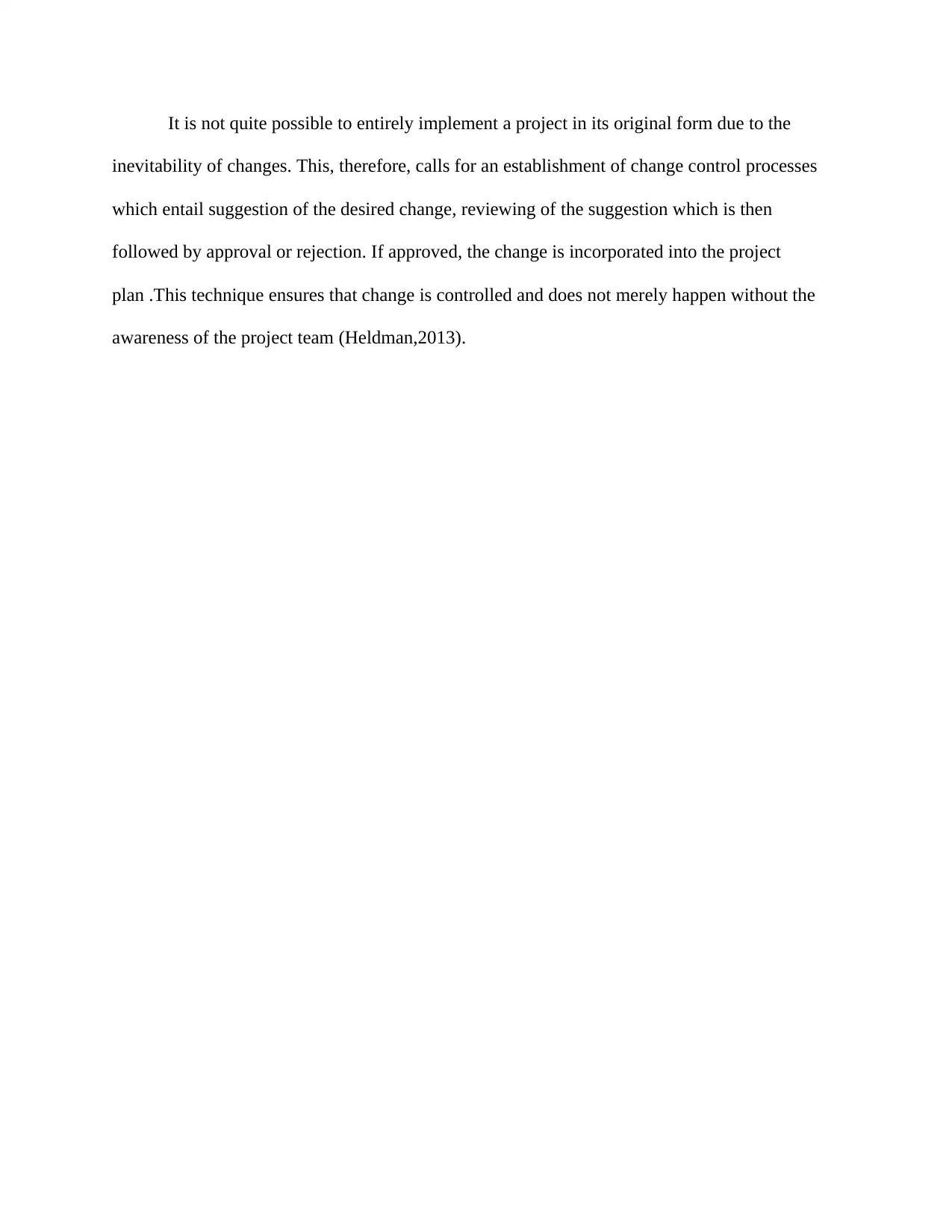
It is not quite possible to entirely implement a project in its original form due to the
inevitability of changes. This, therefore, calls for an establishment of change control processes
which entail suggestion of the desired change, reviewing of the suggestion which is then
followed by approval or rejection. If approved, the change is incorporated into the project
plan .This technique ensures that change is controlled and does not merely happen without the
awareness of the project team (Heldman,2013).
inevitability of changes. This, therefore, calls for an establishment of change control processes
which entail suggestion of the desired change, reviewing of the suggestion which is then
followed by approval or rejection. If approved, the change is incorporated into the project
plan .This technique ensures that change is controlled and does not merely happen without the
awareness of the project team (Heldman,2013).
⊘ This is a preview!⊘
Do you want full access?
Subscribe today to unlock all pages.

Trusted by 1+ million students worldwide
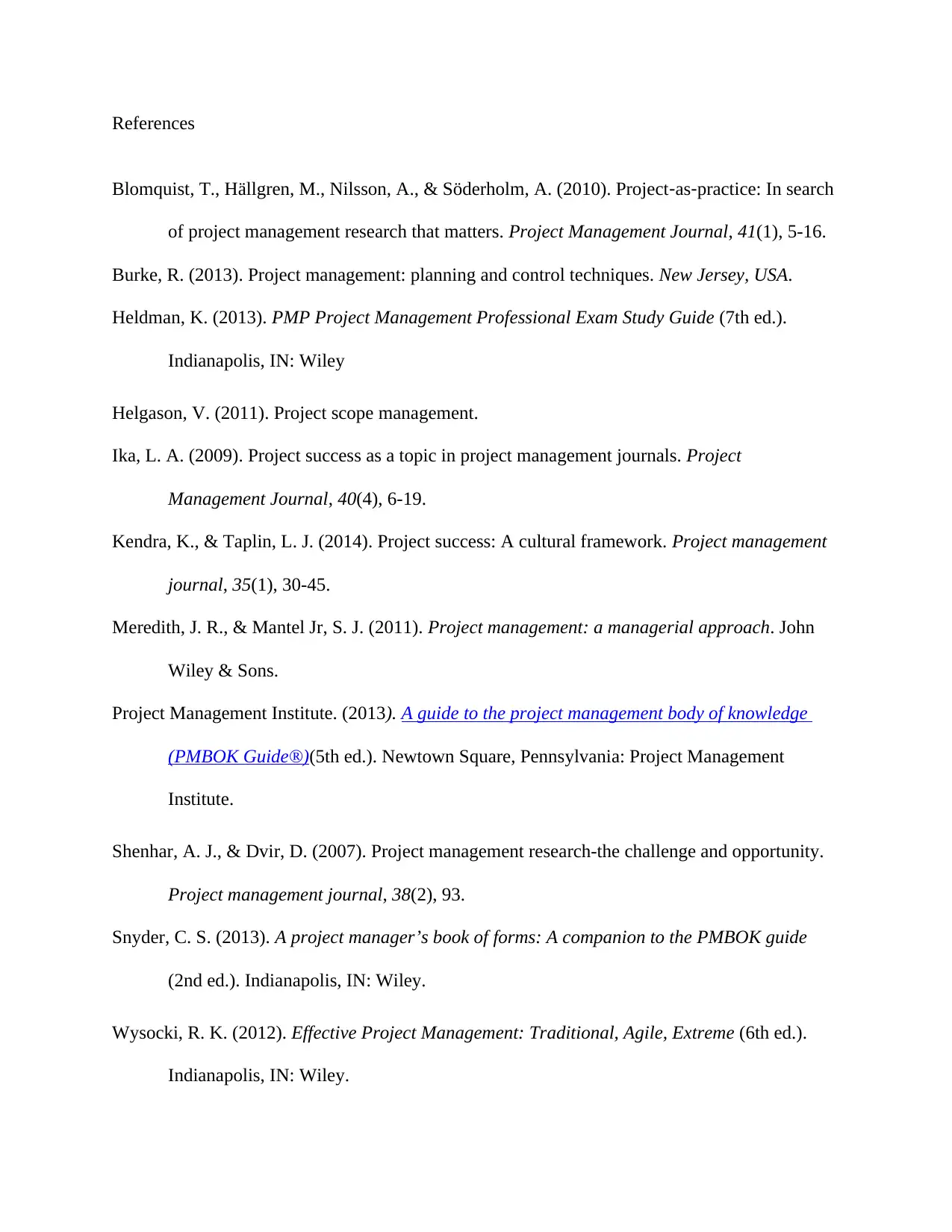
References
Blomquist, T., Hällgren, M., Nilsson, A., & Söderholm, A. (2010). Project‐as‐practice: In search
of project management research that matters. Project Management Journal, 41(1), 5-16.
Burke, R. (2013). Project management: planning and control techniques. New Jersey, USA.
Heldman, K. (2013). PMP Project Management Professional Exam Study Guide (7th ed.).
Indianapolis, IN: Wiley
Helgason, V. (2011). Project scope management.
Ika, L. A. (2009). Project success as a topic in project management journals. Project
Management Journal, 40(4), 6-19.
Kendra, K., & Taplin, L. J. (2014). Project success: A cultural framework. Project management
journal, 35(1), 30-45.
Meredith, J. R., & Mantel Jr, S. J. (2011). Project management: a managerial approach. John
Wiley & Sons.
Project Management Institute. (2013). A guide to the project management body of knowledge
(PMBOK Guide®)(5th ed.). Newtown Square, Pennsylvania: Project Management
Institute.
Shenhar, A. J., & Dvir, D. (2007). Project management research-the challenge and opportunity.
Project management journal, 38(2), 93.
Snyder, C. S. (2013). A project manager’s book of forms: A companion to the PMBOK guide
(2nd ed.). Indianapolis, IN: Wiley.
Wysocki, R. K. (2012). Effective Project Management: Traditional, Agile, Extreme (6th ed.).
Indianapolis, IN: Wiley.
Blomquist, T., Hällgren, M., Nilsson, A., & Söderholm, A. (2010). Project‐as‐practice: In search
of project management research that matters. Project Management Journal, 41(1), 5-16.
Burke, R. (2013). Project management: planning and control techniques. New Jersey, USA.
Heldman, K. (2013). PMP Project Management Professional Exam Study Guide (7th ed.).
Indianapolis, IN: Wiley
Helgason, V. (2011). Project scope management.
Ika, L. A. (2009). Project success as a topic in project management journals. Project
Management Journal, 40(4), 6-19.
Kendra, K., & Taplin, L. J. (2014). Project success: A cultural framework. Project management
journal, 35(1), 30-45.
Meredith, J. R., & Mantel Jr, S. J. (2011). Project management: a managerial approach. John
Wiley & Sons.
Project Management Institute. (2013). A guide to the project management body of knowledge
(PMBOK Guide®)(5th ed.). Newtown Square, Pennsylvania: Project Management
Institute.
Shenhar, A. J., & Dvir, D. (2007). Project management research-the challenge and opportunity.
Project management journal, 38(2), 93.
Snyder, C. S. (2013). A project manager’s book of forms: A companion to the PMBOK guide
(2nd ed.). Indianapolis, IN: Wiley.
Wysocki, R. K. (2012). Effective Project Management: Traditional, Agile, Extreme (6th ed.).
Indianapolis, IN: Wiley.
Paraphrase This Document
Need a fresh take? Get an instant paraphrase of this document with our AI Paraphraser

1 out of 8
Related Documents
Your All-in-One AI-Powered Toolkit for Academic Success.
+13062052269
info@desklib.com
Available 24*7 on WhatsApp / Email
![[object Object]](/_next/static/media/star-bottom.7253800d.svg)
Unlock your academic potential
Copyright © 2020–2025 A2Z Services. All Rights Reserved. Developed and managed by ZUCOL.





